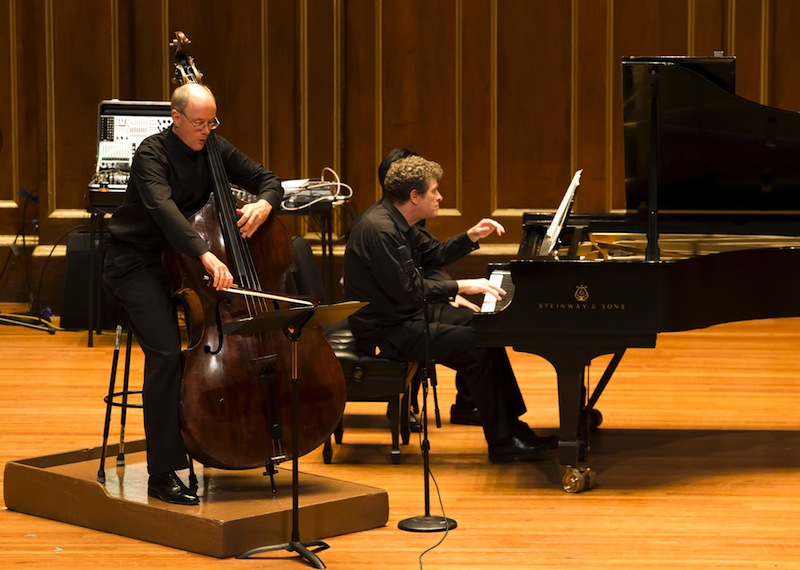Boston Symphony Chamber Players serve up wide-ranging program

Edwin Barker (double bass) and Randall Hodgkinson (piano) performed Hindemith’s Sonata for Double Bass and Piano Sunday afternoon at Jordan Hall. Photo: Winslow Townson
With all of the new music coming out of Symphony Hall over the past month, it was fitting that the Boston Symphony Chamber Players turned their attention to the work of a contemporary composer.
Sunday afternoon at Jordan Hall, the Chamber Players presented two short works by Jeremy Flower as part of a wide-ranging program.
The composer, who lives in the Boston area, has an impressive resume, having written music for the Atlanta and Chicago Symphony Orchestras, the L.A. Philharmonic, and the Santa Fe Opera in addition to scoring films with Osvaldo Golijov.
But the heart of his output is electronic music, and the two works heard Sunday, Shamu and Clinical, featured Flower as performer on piano and electronics.
Both pieces can be performed for a variety of media, though Sunday’s performance featured piano, French horn, and electronics, a format created for BSO principal hornist James Sommerville.
The pieces are simple yet mesmerizing in effect. Flower wrote Shamu for his son and the work is an attempt to capture the simplicity of life as a child. The work opens with a deep penetrating drone over which Sommerville called out stately phrases, which are looped back into the electronic texture. Shamu builds slowly as two notes waver in space, gradually coalescing thick layers of sound before dying away.
Clinical stems from a looped harmonic progression that grows into a steady techno beat. Here too, Sommerville’s floated lines that were simple and tonal. Flower, like a disc jockey, pulled sturdy rhythmic grooves from a laptop and mixer while occasionally adding a phrase or two on the piano.
Taken together, Shamu and Clinical have the direct appeal of film music, presenting a raw emotionalism without resorting to cheap tricks.
The concert opened with J. C. Bach’s Quintet in G major, Op. 11, no. 2. Cast in two movements, this charming divertissement contains some catchy melodies and clever wind writing.
The Chamber Players gave the piece a soft elegant reading. The heroes of this performance were flutist Elizabeth Rowe and oboist John Ferrillo, who handled the numerous flourishes with dexterity. The strings and harpsichord, played with gentle touch by John Gibbons, supplied soft support.
Classical structures were often the basis for the music of Paul Hindemith, whose Sonata for Double Bass and Piano was heard Sunday afternoon.
Rather than spotlighting the soloist, Hindemith’s sonata showcases the pianist and bassist in equal measure. Edwin Barker (double bass) and Randall Hodgkinson (piano) proved sensitive partners who effectively put across the intricacies of Hindemith’s score.
Barker’s tone was deep and resonant, and the bassist mined the lyricism of the composer’s meandering lines, with the phrases of the third and fourth movements crafted into long arcs. Hodgkinson lent soft support to the accompanying harmonies and swelled his tone to match Barker’s angular phrases where necessary.
Fine playing also characterized Sunday’s performance of a rarity by Walter Piston.
The New England composer’s Three Pieces for Flute, Clarinet, and Bassoon is a handsomely crafted work that is full of energy and intensity. Completed in 1925 under the tutelage of Nadia Boulanger, the work was Piston’s first published score. It is cast in a lean style that shows the influence of Stravinsky and Hindemith.
Elizabeth Rowe (flute), William R. Hudgins (clarinet), and Richard Svoboda (bassoon) handled Piston’s nimble contrapuntal lines with clarity, which allowed for the comic elements of to speak for themselves.
Yet there were some gorgeous moments. The second movement unfolded in sheets of silvery sound, and Svoboda’s solo melody managed to sing mournfully. The trio handled the squirrelly runs that open and close the third movement with aplomb, and Rowe brought velvety depth to the solo flute passage that appears mid movement.
The Chamber Players’ concerts this season will feature the three Op. 9 String Trios by Beethoven. The musicians kicked off the survey on Sunday with the first in the series, the G major Trio.
The ensemble, consisting of Malcolm Lowe (violin), Steven Ansell (viola), and Jules Eskin (cello), played the work with a dusky tone that had just enough edge to bring out the intensity of Beethoven’s writing. The outer movements had a rustic verve, while the phrases of the Scherzo moved as if a dance.
The ensemble lost some of its polish in the second movement, where some of chords didn’t lock into tune. But those moments were rare, and the musicians pulled together for the movement’s gleaming phrases, the music taking on a songlike quality in the process.
The next concert given by the Boston Symphony Chamber Players will feature music by Ravel, Dukas, and Dutilleux 3 p.m. January 10 at Jordan Hall. bso.org; 888-266-1200.
Posted in Performances